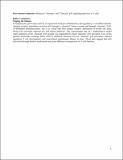Alternative ZAP70-p38 signals prime a classical p38 pathway through LAT and SOS to support regulatory T cell differentiation
Author(s)
Jun, Jesse E.; Kulhanek, Kayla R.; Chen, Hang; Chakraborty, Arup K; Roose, Jeroen P.
DownloadAccepted version (440.7Kb)
Open Access Policy
Open Access Policy
Creative Commons Attribution-Noncommercial-Share Alike
Terms of use
Metadata
Show full item recordAbstract
T cell receptor (TCR) stimulation activates diverse kinase pathways, which include the mitogen-activated protein kinases (MAPKs) ERK and p38, the phosphoinositide 3-kinases (PI3Ks), and the kinase mTOR. Although TCR stimulation activates the p38 pathway through a "classical" MAPK cascade that is mediated by the adaptor protein LAT, it also stimulates an "alternative" pathway in which p38 is activated by the kinase ZAP70. Here, we used dual-parameter, phosphoflow cytometry and in silico computation to investigate how both classical and alternative p38 pathways contribute to T cell activation. We found that basal ZAP70 activation in resting T cell lines reduced the threshold ("primed") TCR-stimulated activation of the classical p38 pathway. Classical p38 signals were reduced after T cell- specific deletion of the guanine nucleotide exchange factors Sos1 and Sos2, which are essential LAT signalosome components. As a consequence of Sos1/2 deficiency, production of the cytokine IL-2 was impaired, differentiation into regulatory T cells was reduced, and the autoimmune disease EAE was exacerbated in mice. These data suggest that the classical and alternative p38 activation pathways exist to generate immune balance.
Date issued
2019-07Department
Massachusetts Institute of Technology. Department of Chemical Engineering; Massachusetts Institute of Technology. Department of Biological EngineeringJournal
Science Signaling
Publisher
American Association for the Advancement of Science (AAAS)
Citation
Jun, Jesse E. et al. "Alternative ZAP70-p38 signals prime a classical p38 pathway through LAT and SOS to support regulatory T cell differentiation." Science Signaling 12, 591 (July 2019): eaao0736 © 2019 The Authors
Version: Author's final manuscript
ISSN
1945-0877
1937-9145